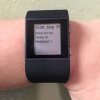Of all the fitness tracking bands we saw at CES, Fitbit‘s Surge was the one we were most excited to try out. Fitbit is a pioneer in the wireless fitness band industry, so they’ve had the chance to witness the evolution of fitness trackers and release new products to remain a contender. They’ve also gone through some rough patches with product recalls and privacy concerns, so we were eager to see if these issues have made Fitbit a stronger company in the end. We were also hoping to finally find a device that could supplant our Pebble smartwatch that has been faithfully keeping time and delivering smartphone notifications for years.
After a month of use, we think it’s become quite clear if the Surge will be a viable alternative to the Pebble, or even the upcoming Apple Watch. So what’s the verdict? Read on to find out!
Design and Hardware
IMG_0290IMG_0292With a rectangular face and a monochrome LCD screen surrounded by a wide, matte bezel, let’s face it: the Surge looks a lot like a Pebble at first glance. This isn’t necessarily a bad thing, however, it’s not a remarkable design either. Along its left and right sides are navigation buttons which are also used in conjunction with the Surge’s touch-responsive screen. The band is made from a soft, textured, silicone-like material that is secured, thankfully, with your standard watch-style clasp. Flip the Surge over and you get a view of the band’s cool, high-tech side. In the middle of its underbelly are two green lights and an optical sensor used to measure your pulse rate. The backside is also where the Surge’s charging port is. Sadly, the connector is a proprietary connection that isn’t even interchangeable with the Fitbit Charge/Charge HR.
Within, the Surge is chock full of sensors. In addition to your fairly run-of-the-mill motion/position sensors (accelerometer, gyroscope, altimeter) and heart rate sensor, the Surge also has a built-in GPS used to track your running routes, when you’re not tethered to your phone’s GPS, and a digital compass to help orient you in the correct direction. An ambient light sensor helps determine when the Surge’s backlight should turn on. Finally, the Surge has a vibration motor to alert you if you’ve reached your goal, started/stopped a workout, or need to be woken up. This suite of sensors is fairly impressive for a fitness smartwatch, and even more impressive is it managed to truly last us close to seven days between charges (with GPS off).
Use
As the Surge replaced both the fitness band we had previously been wearing on our right wrist as well as the Pebble on our left wrist, we were interested to see how it held up as an everyday smartwatch. Unfortunately, the Surge still has a ways to go.
The display itself, while fairly easy to read, is not always easily accessible. In dark environments when the backlight is needed, we had to use our other hand to press one of the Surge’s buttons to activate the backlight. We think it’s practically a given that the backlight should be activated by simply shaking your wrist. Second, as the entire face of the watch is also touch-sensitive, there would be numerous times where an inadvertent touch of the screen would change it away from displaying the clock. The only way to see the current time is to use your other hand to swipe back or press the left button twice (but not too fast as this would activate the music controller). It would be nice if the screen would automatically switch back to the clock view after a few seconds.
Source:Fitbit
One Month With the Fitbit Surge

